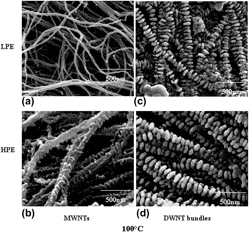Article contents
Effect of surface “groove” structure of carbon nanotube bundles on the formation of nanohybrid shish kebab
Published online by Cambridge University Press: 17 October 2012
Abstract

Nanohybrid shish kebab (NHSK) structure, in which fibrous carbon nanotubes (CNTs) act as shish, while polymer lamellae as kebab, is of particular interest both scientifically and technologically. In this work, two types of CNTs with the same diameter range and different topography structure, namely multiwalled carbon nanotubes (MWNTs) with a relatively smooth surface and double-walled carbon nanotubes (DWNTs) bundles with a groove structure, were used to induce polyethylene (PE) crystallization for the formation of NHSK. For PE/MWNTs system, NHSK was formed only at a relatively low crystallization temperature (Tc), and PE lamellae are not completely perpendicular to the long axis of MWNTs. However, for PE/DWNTs bundles system, NHSK could be obtained even at a much higher Tc, and almost all the PE lamellae are perpendicular to CNTs long axis, due to the unique “groove structure” formed by DWNTs bundles. The enhanced nucleation ability and the facilitated lamellae orientation by using DWNTs bundles are not only of great crystallography interest but also are very important for functional design in nanodevice applications.
Keywords
Information
- Type
- Articles
- Information
- Copyright
- Copyright © Materials Research Society 2012
References
REFERENCES
- 9
- Cited by

